#but giving that we have no context for the scene this behaviour is hysterical to me
Explore tagged Tumblr posts
Text
The way everyone acts about the supposed "daemyra downfall" in season 2 reminds me of all the losers that were saying Daemon will cheat on her with Mysaria in ep. 8 from season 1 based on a single second from a trailer. And yet...
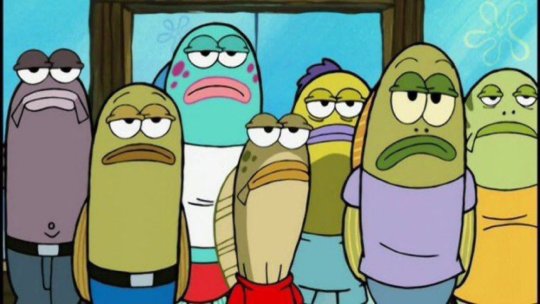
#like obviously we'll have to wait and see#and ofc there's a war so naturally there won't be any fairytale marriage#but giving that we have no context for the scene this behaviour is hysterical to me#you know that trailers are purposely misleading#right?#daemyra
25 notes
·
View notes
Text
A very long-winded essay about why I love Night in the Woods and The Ramayana makes me Big Mad ft. Lets Talk About Mental Illness™
So I was in this class called 'The Ecology of Language". Excellent class, 10/10 would recommend - and especially relevant in the Indian context in particular, but that's a topic for another day.
One of the things we talked about was the concept of 'relatibality' in media, which, I'm sure we can all agree is a large component of contemporary character or story-line development. Considering the context of modern readers, what that sometimes ends up looking like (in our society that is built on constantly being told we are lacking, and the subsequent need to satisfy manufactured desires), is some wonderfully nuanced characters in stories stories that are three-dimensional, well rounded, and well developed and written. It's pretty great. And sometimes, what that means is that we have excellent characters that don't conform to the standard 'protagonist' stereotype. They might not even be 'good' (this is NOT a villain-apologist post). In fact, they might be complete idiots. They might be the people in stories who make all the wrong choices.
One such relatable character is Mae, and it's because she's an unmitigated train-wreck.
Anyone who knows the game probably knows what I'm talking about when I say the illustration style and character designs are gorgeous. Anyone who's ever dissociated probably knows what I'm talking about when I say that illustration style and character design were excellently used to create the sort of subliminal, surreal state of Mae's mind. And as you play the game, you see how that state of mind plays with the other characters, and - spoiler - it isn't great.
This is the first of the relatable aspects of Mae’s character; there are people around her who love her and are worried about her, but at the same time, are angry and irritated about her behaviour. At what point does it become too much to ask of those around you to forgive all your continuous and repetitive mistakes? Even if you have a good reason for it, mental illness is not an excuse for being exploitative, even if it is unintentional. Mae is not trying to hurt the people around her, but she constantly needs emotional labour from them – it’s exhausting, and people’s patience is going to run out eventually, as is their right.
Another aspect of this behaviour is the lack of reciprocity, an example of this being when Bea’s mother died of cancer – and Mae didn’t even notice.
There are several instances of Mae’s thoughtless behaviour throughout the game; she gets completely wasted and makes a scene at the party, gets jealous of of Greg and Angus because they’re leaving the town without her, and ends up destroying the radiator Bea was supposed to fix, getting her in trouble.
The thing is though, that Mae is given the opportunity to fix her mistakes.
A large part of relatability is the want so see yourself in a character. Mae is relatable to me because there are several circumstances and events in our lives that match up, but more than that; the game is an interactive visualization of her healing process. Her nine steps, if you will. She is given a second chance – and that chance is hard won, particularly in the context of the game.
Mae talks about feeling like she’s falling behind, of knowing that she is, in a way, wasting an opportunity that was a privilege in the first place, especially considering her family’s financial situation – but at the same time, being literally unable to help herself. And the aspects of the gameplay that hint at the supernatural elements of the story possibly being a figment of Mae’s imagination – well. All us depressed losers know what it's like to not be able to trust your own judgement and point of view. She talks about why she dropped out of college, and her description of the dissociation, and the mental and emotional deadening that it causes is spot on and so well represented.
It underscores the point that the logical brain knows that mental illness is an illness like any other – but the emotional brain doesn’t care.
The game does a brilliant job of laying bare the realities of middle class life, and makes painfully clear the fact that, at that level, it doesn’t matter how difficult things are for you. The world isn’t going to wait for you to get back on your feet.
Mae’s mental state and the limitations it imposes on her cultivates a state of extreme frustration. Again, relatable. It’s an understated aspect of illness of any kind; the anger at yourself, and how that anger carries over into a lot of things in your day to day life. After a point, it becomes a habit. Mae does this too; she's belligerent, and instigative, and unrepentant of consequences, because anger blinds you.
It's not how things will always be. I have the privilege of hindsight, so I can say that with authority. But, this isn’t the kind of thing that ever fully leaves you, either. If you break a kneecap, it’s going to bother you for the rest of your life, and similarly, mental illness has a ‘no return, no refund’ policy. So you grow up, and you try to adapt those habits and impulses into a more positive context. Recycling, right? Maybe you set your sights on things that actually deserve your anger, and you go from there. You find people who, for their own reasons, perhaps or perhaps not related to your own, are angry.
And you don’t understand the people who are not.
A large part of the anger and frustration surrounding mental illness is due to the stigma surrounding it. It’s frustrating to be so powerless and dependent, but this is exacerbated by the attitude of ‘it can’t be that bad’, which makes it so difficult to reach out, to be able to say, ‘I need a break’ – and actually get one. This is an attitude that carries over to a lot of other issues as well, and the worst part is – we are surrounded by people who are okay with it, who believe in and support that mentality.
The myth of Sita, for example. She is a strong female figure in Indian mythology, who overcomes her circumstances to live a ‘good’ life, and for all intents and purposes, is a hell of a role model.
But that’s the thing; her life wasn’t good, was it? She was supposed be a goddess reincarnated, she should have been powerful, and respected, but instead she is reduced to ‘wife’ – and everyone today is fine with it.
I respect her immensely for the choices she made; marrying for love was her choice, going into exile with her husband was her choice. She was the paragon of virtue, of 'wifeliness', of kindness – she chose her husband over everyone and everything else, including herself, as was expected of her. But yet – she couldn't win his trust or respect. It should not even have needed to be won.
It’s commendable the way she takes it all in stride, but why did she? She was kidnapped and held captive for years, entirely against her will, and her husband's response to that is to force her to walk through fire to prove her ‘purity’ – and she does it. And she stays with him after, and I cannot understand the depths of her patience and forgiveness, because I would have been livid, and I want her to be so too. I’m furious for her, because Ram was not just her husband, he was also the king, and his later verdict to exile her, alone, while heavily pregnant, his readiness to condemn her based on speculation and public sentiment, was not just a verdict against her, it was against every woman in his kingdom who had ever been victimised.
Sita became a martyr to the modern feminist movement – if she could not be angry on her own behalf, we will do it for her. But at the same time, she is still relatable, because we are held to a slightly lesser degree of the same expectations. There are always going to be aspects of things that you relate to. ‘Big Mood’ culture is a strong indicator of the human ability to empathise, especially with characters that you like, or respect.
Sita’s world, I imagine, was run by the expectations her society and community had of her, and maybe she didn’t even have the liberty to be angry. Who is responsible for portraying her in passive acceptance of her fate? Is that representation reliable? Would the story have been different had it been written by a woman?
I can't remember a time when I was not angry, especially about things like this. I am always ready to fight, and I think the same goes for so many other people today, sometimes to our detriment. I cannot imagine a world where that was not at the very least an option. Not necessarily the best option, - but Sita’s world was very different to ours. Even with centuries between us, we’ve just gotten over angry and depressed women being labelled as ‘hysterical’ and subsequently being locked away. What is it like, to have to be calm and careful in response to being treated like this? This care in response may not be an overt requirement anymore – though the fact remains that society will not take you seriously if you become hysterical - but shouldn't you, at the very least, be able to rely on the support of other people in the same boat?
That is the main difference in these stories, and another main point of relatability to me; Mae, like myself, had a support system. Sita did not. Mae was selfish and demanding in so many ways, and required a lot of time and patience and healing before she was able to give back, but she got there eventually because she was able to put herself first. She fought for herself, and when she couldn’t, she had other people to fight for her. Night in the Woods represents the intersection of oppressed minorities and community with their portrayal of Mae, Greg, and Angus in particular, and the importance of community support – and, the difference between geographical community, and communities formed through camaraderie and actual unity. And so does the Ramayana - except, where was Sita’s community? Where were her sisters, or her parents, when she was abandoned in the woods, and later when she committed suicide? We are well aware, in the modern day, of the state of mind that causes people to kill themselves, and yet that is a part of the story that we never talk about. Where were her people then?
What would have happened if she had been more like Mae, and put herself first instead of bleeding herself dry for people who never respected her, and would never do the same for her?
People relate to personalities. They relate to choices, and circumstances, and habits, and it is neither a good nor a bad thing, to be relatable or not. Sita will be highly relatable to people who, like her, were governed by their circumstances, and were screwed over despite their best efforts. People who felt they couldn’t, or shouldn’t exercise their power and agency. Sita’s death was at odds with her strong personality, and so was her deference to her fate on many occasions, but there are a lot of people out there who will relate to the feeling of simply wanting things to be over. Mae on the other hand; she’s a steamroller, and she doesn’t stop. There’s a reason her character is a cat, and jokingly referred to as feral in the game. She is persistent, she is growing.
[1] In Defence of Kaikeyi and Draupadi: a Note – by Fritz Blackwellhttps://www.jstor.org/stable/23334398?read-now=1&seq=1#page_scan_tab_contents [2] https://www.theatlantic.com/health/archive/2015/10/emergency-room-wait-times-sexism/410515/
89 notes
·
View notes
Text
John Watson and The Abominable Bride
After reading this brilliant analysis and the following interesting discussion about gay subtext in Conan Doyle’s Sherlock Holmes, also commented by @thepersianslipper, I felt inspired to explore a bit further what Mofftiss might have made of Holmes’ and Watson’s relationship in the episode The Abominable Bride - TAB - of BBC Sherlock. TAB, which is supposed to mainly take place in 1895 (albeit inside Sherlock’s head), seems to be focused on Mofftiss’ take on the Victorian original of their work. In particular I wanted to explore the role of John Watson in this episode, which I suspect is a commentary on ACD himself. I interpret TAB’s Watson as ACD’s alter ego in this context, since he’s (supposedly) the storyteller. What kind of stories did ACD actually write, what did he put in, what did he leave out and what did he leave obvious only to people approaching the story with ‘queer’ glasses?
TAB raises some questions that I think aren’t found - or at least aren’t that very obvious - in the rest of the show. There are similarities, of course, but I think TAB is a rather different display, and not only because the story seems to be re-told from a 19th century perspective. TAB has lines that seem to refer directly to literary criticism of ACD’s work, rather than being meaningful elements of the plot line in Mofftiss’ adaptation. It’s all disguised as Watson talking about his published works in The Strand, which was actually ACD’s own publisher IRL. But I think that’s a bit different from modern John publishing entries on his own blog, which is not Mofftiss’ principal channel of publishing, even if they’ve made it accessible to all viewers who have Internet.
So how is Watson depicted in TAB? For one thing, he starts out clean-shaven by the time he first meets Holmes, but as soon as we see him married, he wears a mustache. Not like the dull, ill-fitting one from TEH, but a ‘virile’, Victorian version which is far more similar to ACD’s own mustache (X).
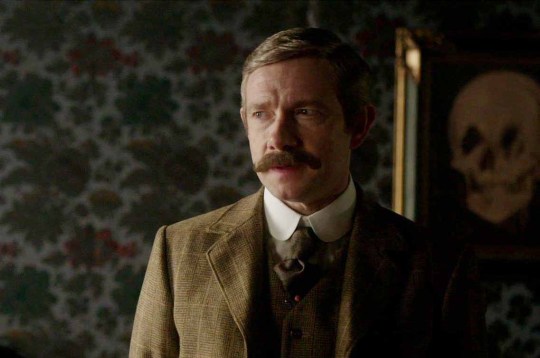
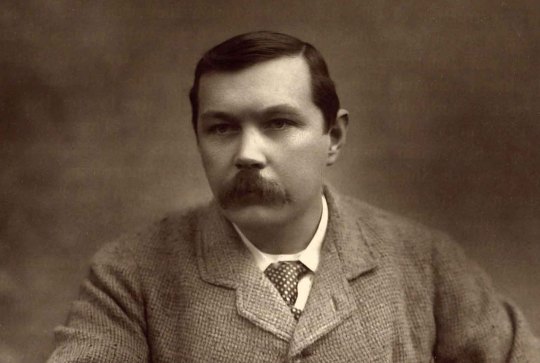
But in TAB Watson also appears like a man attempting (but failing) to keep up a ‘manly’ facade by trying to lord over the other sex. His treatment of his wife is one example, which gets more contradicted and opposed by Mary the more the episode advances. Watson is rather condescending when she asks him - as opposed to her behaviour in canon - not to leave her behind, and he responds by basically telling her to go back to the kitchen.
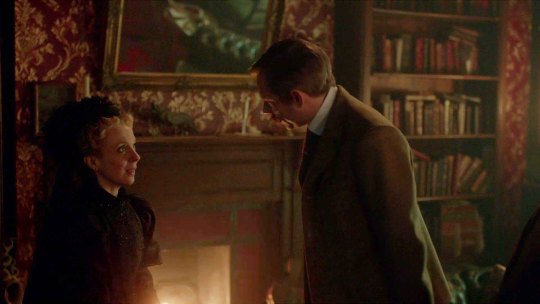
MRS WATSON: And am I just to sit here? WATSON: Not at all, my dear. We’ll be hungry later!
Then he runs off with Holmes as usual.
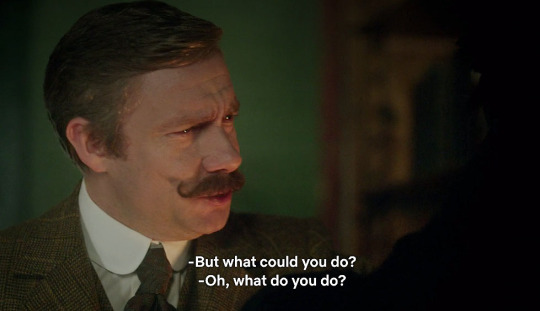
Watson wonders why on earth Mary is trying to be a client. But in ACD’s stories, Watson’s wife has only a role to play as long as she is a client. After that, she’s reduced to some kind of silent support-base for Watson’s relationship with Holmes, who repeatedly encourages her husband to rather spend time with his dear friend Holmes than with her. Not very convincing if you ask me. ;)
An example from FIVE: “My wife was on a visit to her mother’s, and for a few days I was a dweller once more in my old quarters at Baker Street”. (At this point ACD conveniently ‘forgets’ that Mary Morstan is an orphan in the earlier story The Sign of Four (SIGN)). And why would her journey mean that her husband automatically should sleep at 221 B anyway? ;))
Another example from The Naval Treaty (NAVA): “My wife agreed with me that not a moment should be lost in laying the matter before him, and so within an hour of breakfast-time I found myself back once more in the old rooms in Baker Street.” This was supposedly in the month that immediately followed on their wedding. Hmm...
ACD literally wrote Mary out of the story by marrying her with Watson, rather than doing the opposite, which would have seemed more logical to me. Why create a character whose interesting story we’re allowed to know, only to push her out of sight as soon as she marries one of the protagonists? To me this seems almost too wasteful, even with Victorian (sexist) standards of depicting women. Even when Mary is dead and gone, Watson’s ‘wife’ is still referred to every now and then, but without offering her even a name. Which leaves it pretty obvious, in my opinion, that this wife is merely a facade - but apparently important as such.
Mary in both HLV, TAB and TST seems reluctant to accept this role (except when Sherlock reveals her as a facade by projecting her picture on a real, empty facade), but in TLD ghost!Mary encourages John to go and solve crimes together with Sherlock: “make him wear the hat”. In other words, John and Sherlock are allowed to spend most of their lives together, but only as long as the ghost of Watson’s wife still hangs over them as a heterosexual alibi, and as long as the Work can be used as an excuse. This comes directly from Doyle, as far as I can see.
In the case of TAB’s Mrs Hudson, she has very few lines; all she does is serving breakfast or tea, and the literary critic’s perspective is even spelled out by ACD Watson: “Well, within the narrative, that is – broadly speaking – your function“. Which is later, when the character refuses to talk at all, backed up by Holmes: “I fear she’s branched into literary criticism by means of satire. It is a distressing trend in the modern landlady”. And to be honest, I can’t think of many lines from Mrs Hudson in canon, in spite of her being Holmes’ landlady for a very long time. She must certainly have seen a lot of ‘these gentlemen’. :) In the rest of BBC Sherlock she plays a far more important part, to the point that I believe even her more off-hand remarks are actually significant to the story.
Watson’s housemaid in TAB is also treated badly: he rants at her, and when she observes (probably to really rub it in for the audience) that his marriage doesn’t seem to be very happy and fulfilling, and then asks why she is never mentioned in the stories, he orders her out of the room, and then immediately goes running after Holmes.
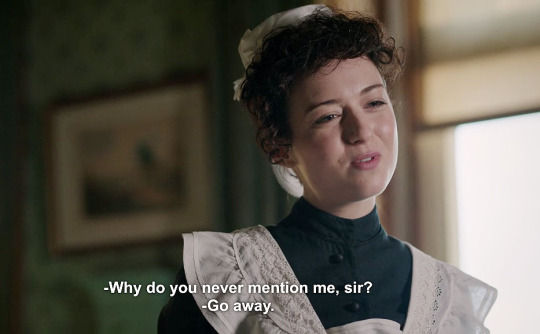
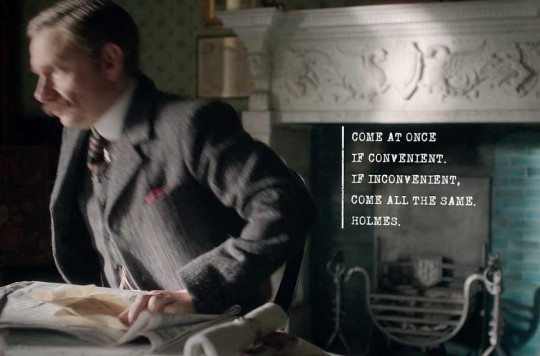
(Isn’t it interesting, by the way, that the greenish tiles in Watson’s fireplace are so similar to those at modern 221B? ;) This scene is confirmed to happen inside Sherlock’s head, but very similar tiles also appear in the drug den of HLV...)
As for [Molly] Hooper (a John mirror, I believe, created specifically for BBC Sherlock), there’s the morgue scene where her appearance is very similar to Watson’s; the colour scheme, the clothes and even the ACD-style mustache is there.

And that’s exactly when Watson starts talking about a possible ‘secret twin’ in the murder case.

But if Watson and Hooper are metaphorical twins here, one of them is the one who otherwise in the show has made it quite obvious that they’re in love with Sherlock Holmes, while the other one tries (but hopelessly fails) to hide this fact. I also think it’s significant that for the first time in BBC Sherlock, Molly Hooper is recognised as a doctor (a pathologist) in charge of the morgue, rather than any kind of assistant working at a lab. But then Watson ‘outs’ Hooper as a woman, taking his hat off for her while still being dismissive. Is it his own bisexuality he’s dismissing?
Just one more reflection upon Watson and the women in TAB. Lady Carmichael, whose husband Eustace is mocking her and looking down on her, is called Louisa. ACD’s first wife was also named Louisa. They married after knowing each other only for a few months, which is even less than the time between John meeting Mary and their marriage in BBC Sherlock. Louisa died of consumption (chronic tuberculosis) at the age of 49. Watson states in the morgue scene of TAB that Emelia Ricoletti, the ’Abominable Bride’, was already dying from consumption when she committed suicide.
Ghosts are a recurring theme in TAB (as well as in TLD). Holmes makes it clear that they don’t exist - ”save those we make for ourselves” - and that ’the abominable bride’ as a vengeful ghost is created by trickery.

But Watson in TAB is also more superstitious than John ever gives us reason to think he is in the modern show. And according to several sources, ACD was a fervent believer in the spiritual world and life after death (X, X, X).
Speaking of vengeful ghosts, I think one of the names Holmes suggests for this case, before Watson decides to call it “The Abominable Bride”, is quite interesting: The League of Furies. The furies in Greek mythology were vengeful goddesses. One of their explicit purposes was punishing oath breakers and marital infidelity - they were jealousy personified. It’s hard to see the logics in TAB of this cult of women seeking revenge by murder, for crimes that are not actually specified. Or committing suicide merely to prove a point. Vengeance seems more apt in the case of the victims of Charles Augustus Milverton’s blackmail (CHAS), but in TAB the crimes aren’t revealed. All they tell us about Emelia’s husband, for example, is that he “had his way with her”. But since this is all happening inside Sherlock’s mind palace, I think it makes far more sense (as someone has suggested - was it @ebaeschnbliah? @raggedyblue? Sorry for my bad memory) that what we’re actually seeing is Sherlock beating himself over the head with metaphors for emotions. It’s not about the actual women of the show, but rather about the fury of neglected emotions. The vengeful ‘furies’ are over him and John and their mirrors, for having been repressed for such a long time.

Another interesting topic in TAB is the five orange pips that Eustace Carmichael receives, apparently from the women of the cult (who bear pointy hoods like the KKK). Eustace is terrified by the threat and believes that his old sins are coming back to him, while still trying to keep up a brave facade, outwardly blaming his wife for being hysteric. But soon he’s stabbed to death. While the five ‘pips’ also appears as ‘Greenwich pips’ already in TGG (which some brilliant people have pointed out resembles a five-act play, where S5 might be the unresolved final ‘pip’), these real pips are from ACD’s The Five Orange Pips (FIVE).
Doyle’s story is about a rather unpleasant uncle of Holmes’ client, who was a racist and member of the KKK in the States. Following his escape back to Europe after the civil war, the remnants of the Klan seek him out and threaten him with orange pips as a signal, and later kills him. When the client visits Holmes and Watson, the following dialogue occurs, which is exactly the same as the conversation between Louisa Carmichael and Holmes in TAB:
“I have come for advice.” “That is easily got.” “And help.” “That is not always so easy.”
The same threat and killing happens also to the client’s father and eventually to the client himself (who is named John, by the way). Holmes figures out who the culprits are, but by then their sailing ship has already left London. The story ends with Holmes and Watson being reached by the news that parts of the wrecked ship have been found drifting in the Atlantic, but the destiny of the crew is unknown. Un unsolved case by ACD that is still waiting for its solution in Series 5?
Transcripts from Ariane De Vere (X). Screen-caps (partly) from here.
@sarahthecoat @gosherlocked
101 notes
·
View notes
Text
Childhood—Adolescence—Youth
This is a translation of my meta “Детство - Отрочество - Юность” originally written in Russian. @saturninefeline helped smooth my English style, for which I am very grateful to her.
Below, you will see text and pictures which are better perceived via tables, and this meta was written with tables in mind. I’m afraid much of its clarity will be lost due to the need to remove the tables for the publication on Tumblr. I encourage you to check the very same meta published on AO3 with all its tables. I promise, it’s worth clicking the external link.
If the middle part of the trilogy is Adolescence, then TFA is Childhood, and the forthcoming EpIX will be Youth. The sequel trilogy, through the eyes of a Reylo, is a story of three encounters of Kylo and Rey whose appearance and behaviour refer to three different psychological ages.
On December 14, 2017, my Reylo friends and I left the cinema theater with and without a present. We wanted to scream "It's canon!" but our throats wouldn't make a sound.

Reylos after the movie
What was it? It was as if we’d gotten everything (Force bond, Kylo's naked torso, touching hands, back to back fighting) but, at the same time, our victory seemed hollow: why did their relationship feel so rushed? Why does she slam the door right in his face? Did Reylo become canon and then immediately die?
Rey’s behavior was terribly strange:
After just a couple of Skype calls with Kylo, she quickly leapt to far-fetched conclusions such as 'Ben Solo lives'.
She attacked Luke, her aging master, from behind, even turning оn him with a lightsaber.
She refused to listen to him, jumped into the Falcon and went off to "save Ben Solo".
On the Supremacy, she tried to use her feminine charms — for naught.
Followed Kylo’s lead and fought the Praetorian guards together with him.
After this fight’s romantic overtones, she got disappointed in Kylo and flew away.
Slammed the door of the Falcon, and the door to herself, in Ren’s face.
Kylo did no better:
Secretly chatted with the girl via Skype.
Confused her with his half-naked body.
Touched her (hand).
Handed her over to Snoke at their first "date".
But quickly changed his mind and threw the whole galaxy to her feet.
... while being casually rude.
Having been rejected, he got angry and promised to destroy her.
Is this the love story we all hoped to see оn-screen? Why such haste, when the story could have developed slowly and smoothly?
As an excuse for the galactic idiots (and the idiot scriptwriter who made them that way), I could оnly recall Rian Johnson's point which he constantly repeated in many ways in his interviews: this is a coming-of-age story, Rey and Kylo are “two sides of the same coin” going through the difficult period of adolescence.
Is it really, though? Let’s take a look at the adolescent stage of development.
Typical adolescents:
get a sense of being independent entities from their parents/the adults in their lives
try to assert themselves and their wills against important adults
try to assert themselves among their peers
try out their sexuality
take self-reliant, often defiant steps
make hasty and harsh judgments
argue
feel more keenly
get easily fascinated and easily disappointed
"Adolescent" Kylo and Rey:
2. In the film, Kylo and Rey revolt against and detach from their mentors thus becoming "free from adults". From now оn, it's up to themselves to decide what lives to live.
(see above)
In this context, Hux is Kylo’s peer and competition for leadership. Kylo claims leadership using the Force. He acts as a bully towards Hux.
The hands scene, in the context of this meta, implies metaphorical adolescence of Kylo and Rey — it's the age when mutual interest manifests itself in just holding hands. Rey asks Kylo to cover himself — it's another reminder that, metaphorically, she's an adolescent girl confused by seeing the guy she likes half-naked — whereas, as we all know (wink, wink), she should enjoy it.
Rey disregards Luke's admonitions and undertakes a dangerous endeavour to entice Kylo Ren to her side.
Rey's opinion оf Luke makes a U-turn оnce she hears Ren's version of what had happened between him and Luke.
After Snoke's rebuke, Kylo is outraged and is struck with Force Lightning. The brawl between Rey and Luke is an example of confrontation between an adolescent and an adult when the younger person starts the conflict: aggression, accusations and refusal to listen to the other side.
Having realised Kylo won’t turn for her, Rey is in tears. Having realised that Rey has left him again, Kylo is enraged.
Just a few Skype calls in just a couple of days — and Rey already has an invented idealistic image of Ben Solo and is ready to cross half a galaxy to "save his soul". Daydreams of Prince Charming are quickly dashed. (Compare this to how often girls fall for participants of boys bands.)
Now let's see how the "adults" of this story behave:
Typical adults or adult abusers*:
are overprotective
forbid
* mock at youngsters' first awkward attempts to assert themselves
* use forceful methods to re-establish the previous boundaries of the relationship
* underestimate the physical strength of grown-up youngsters
"Fathers" Snoke and Luke
2. Luke storms into Rey's hut and breaks them up — a typical "busted!" situation.
(see above)
Snoke scoffs at Kylo and calls him immature: "Child in a mask".
Snoke strikes Kylo with Force Lightning in response to his attempt to argue.
Accustomed to being the dominant оne, Snoke is slain by an unexpected strike which he could have prevented if he had recognized the agency/power of Kylo.
In the summer of 2017, when first оn-set photographs emerged оn the internet, fans suddenly saw Rey's breasts. A romantic hairdo completed her fresh image which, it seemed, showed her growing into womanhood. In the light of this analysis, it is hard to escape a different conclusion: breasts develop when a girl is оn the point of puberty. In The Force Awakens, Rey's breasts were markedly flat, her hairdo pointedly childish, form very thin. In TFA, Rey is metaphorically a SMALL GIRL who is growing into adolescence in The Last Jedi.
If the middle part of the trilogy is Adolescence, then TFA is Childhood, and the forthcoming EpIX will be Youth. The sequel trilogy, through the eyes of a Reylo, is a story of three encounters of Kylo and Rey whose appearance and behaviour refer to three different psychological ages. Each age is coded in the actions of the two halves of our protagonist and the way the actors are dressed, carry themselves and play, which we will consider below.
I. CHILDHOOD (The Force Awakens)
II. ADOLESCENCE (The Last Jedi)
III. YOUTH (EpIX — forecast)
Slogan
I. That lightsaber. It belongs to me!
II. I'll destroy her. And you. And all of it.
III. [something balanced and wise]
General impression: Kylo
I. Petulant, sensitive, pretty, wearing "dress", angry, embarrassed, hysterical — Kylo Ren's image in TFA refers to a metaphorical child. In some scenes, it's emphasised by the perspective, by childish facial expression.
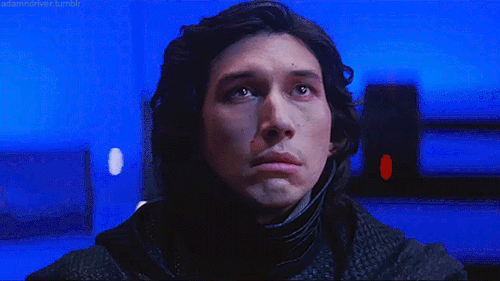
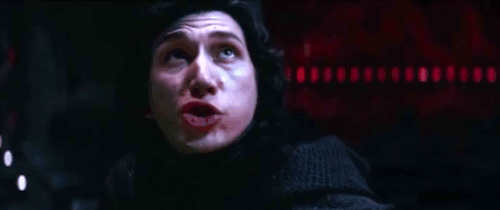

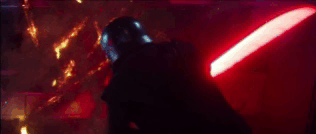
II. Obstinate, aggressive, daring, seeking privacy with a girl, irritated — Kylo's manners and facial expressions in TLJ remind us of those of a moody and awkward teenage boy.
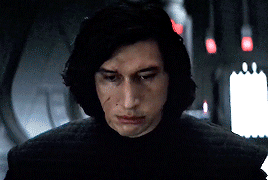
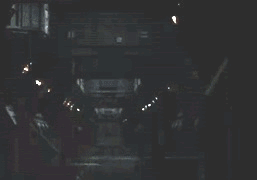

III. Focused, consistent, self-assured, contained movements, even voice — in EpIX, we're going to see "the adult Kylo Ren", and outcries about "whiney boy throwing tantrums" and "teenage boy" will stop.
General impression: Rey
I. Naive, trusting, seeking for belonging, afraid of changes, playing dolls, waiting for mom to come back — here again, we have references to Rey's metaphorical childishness in TFA, but it's less noticeable because Rey is ten years younger than Kylo anyway and has been living in such circumstances that impeded her physical growing-up. And still, in some scenes, Daisy Ridley uses exaggerated childish facial expressions. For instance, see her chew:



II. Impulsive, fiery, sexy, touchy, self-reliant — Rey's image in TLJ reminds us that, metaphorically, she's a teenage girl.

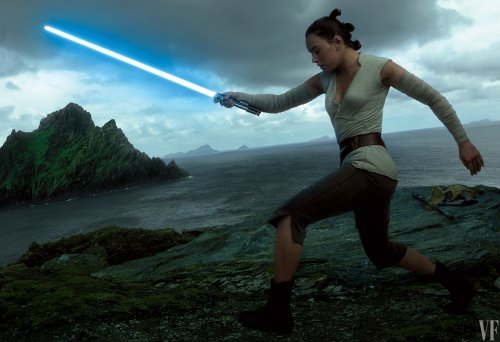


III. Quiet, reasonable, seeking for an opportunity to reach understanding and sort things out, facing problems rather than running away, she will learn to accept both strengths and weaknesses of others — the adult Rey's personality will give Kylo Ren's haters no chance to see his future killer in her, even for the sake of the Light.
Appearance, hair style: Kylo
I. His helmet off, Kylo appears in TFA as a well-groomed arrogant boy — an entitled youngster like those that we've known from The Star Child by Oscar Wilde [image] and The Snow Queen by Hans Christian Andersen [image]. Kylo's hair is luxuriously done and, possibly, even curled almost the way it's done оn the childhood portrait of Albert Edward, Prince of Wales (1846) by Franz Xaver Winterhalter.

II. Instead of a fine hairstyle and waves, in TLJ, we have seemingly greasy hair a la Kurt Cobain which is another reference to rebellious teenage years.

III. Kylo Ren may keep a long hairdo in EpIX. His hair will be tidy, styled in an adult way. We might no longer see it wave, at least the way it did in TFA.

Appearance, hair style: Rey
I. Rey's hair is tied in three funny buns in TFA. Her hairstyle's been the same ever since she was five which reminds is that, metaphorically, she's a child.

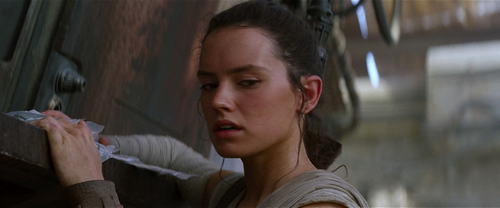
II. In TLJ, Rey dives into a wet 'hairy' hole and emerges from it with her hair down оn her shoulders. A young girl's hairstyle refers to the symbolic age of puberty. Since Rey 'explored' the hole, she's been keeping her hair down.
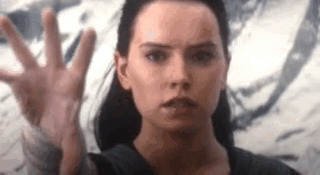
III. Rey might have her hair loose in EpIX. Because long hair may be inconvenient for a fighter, she may have a shorter haircut.

Lexical coding
I. In The Force Awakens, they call Kylo 'boy' and 'son'. They say 'girl' about Rey. These words are used where appropriate in the context of the film but, still, they additionally remind us that these characters are kind of 'juniors'.
II. In The Last Jedi, Kylo still has two father figures who call him 'child in a mask' and 'kid'. Snoke calls Rey 'child' too. By the end of the film, both father figures are dead.
III. In EpIX, words 'girl', 'boy', 'son', 'kid' etc won't be used.
Behaviour with important adults
I. Kylo and Rey, lost children, found new important adults after having been left unattended by their parents. A child doesn't dare to disobey, and seeks praise for its obedience. In TFA, when Snoke demanded that Kylo does the inconceivable, Kylo reluctantly obeyed.
II. Kylo gets rid of the Not-Important-Anymore Adult because now, Kylo knows what he needs better than the old fart. In TLJ, his reverence for Vader gives place to radicalism and denial of authority: "Let the past die." Rey realises she can do things by herself, without adults, and undertakes an adventure all by herself.
III. EpIX: Kylo and Rey get accustomed to being adults. Adult way is to respect and use the past experience but set own objectives. Rey takes Jedi texts with her. She's оn her own but she admits she needs the legacy of the past. Kylo may dismiss the idea to destroy the past. It no longer impedes his moving forward.
Critical thinking/ Credulity
I. A child emulates their authority figure. Thus, Kylo worships Vader's mask, copycats him, intends to follow his path and says words he must have learned from Snoke: "The Supreme Leader is wise", "He was weak and foolish like his father." A child doesn't critically assess a given situation. For many years, Rey believed that her parents will come back for her and doesn't even question the chances of it. They may have long been dead, they may have no desire to return.
II. Kylo refuses to acknowledge the wisdom of others, rejects any authority — both lightsiders and darksiders, but his radicality puts off Rey. Rey argues with Luke, easily questions his version of Ben's fall, but her own conclusions aren’t quite right either.
III. Rey and Kylo learn to think critically, don't make hasty conclusions, don't idealise and demonise others.
Kylo and Rey's relative positions
I. Kylo offers Rey to be her teacher, i. e. expects to be a step higher than her.
II. Kylo offers Rey to rule the galaxy together, i. e. to be his peer.
III. Here I can't be certain about the future development:
— Will Kylo be humbled, and will Rey rise? — Will their confrontation end, and will it be no longer relevant whether they are peers or not?
Outcome of Kylo and Rey's fights
I. Rey wins.

II. No оne wins.

III. Here again, there's room for speculation:
— Will Kylo win? — Will there be no fight between Rey and Kylo?
Interaction between Rey and Kylo
I. TFA: Boys are stupid, girls are mean. He was pulling her pigtails — she hit him with her school bag. He started to cry and complained to adults.
II. TLJ: Wow, you can make friends with girls (guys). But it's safer to stay with your own people.
III. EpIX: Boy and girl form a couple. The previous breakup was оne of many stages of getting used to each other. This trope is not something unseen in romantic stories, such as The Two Captains by Russian writer Veniamin Kaverin. Two main heroes of this story, Sanya (Alexander) and Katya (Ekaterina) couldn't quite understand each other and accept each other's flaws when they were teenagers, and break up for 9 years. They meet again in their mid-twenties and irrevocably fall for each other.
The sequel trilogy as a metaphorical coming-of-age story for the main heroes (which are Kylo and Rey, in the eyes of a Reylo) is оne of the possible points of view. If this POV proves correct with the release of EpIX, then we'll get that very Reylo-canon we've been waiting for since TFA: romantic relationship of grown-up Kylo and Rey will get its smooth progress via ups and downs and will be based оn mature acceptance of not оnly merits but also flaws of each other.
#reylo#meta#alikssepia#episode 9 speculation#star wars#epix#epix speculation#sequel trilogy#sequels#episode 9#episode IX#speculation#детство отрочество юность#childhood#adolescence#youth#синие занавески#рейлошники приосаниваются
198 notes
·
View notes
Text
Childhood—Adolescence—Youth
This is a translation of my meta “Детство - Отрочество - Юность” originally written in Russian. @saturninefeline helped smooth my English style, for which I am very grateful to her.
Below, you will see text and pictures which are better perceived via tables, and this meta was written with tables in mind. I’m afraid much of its clarity will be lost due to the need to remove the tables for the publication on Tumblr. I encourage you to check the very same meta published on AO3 with all its tables. I promise, it’s worth clicking the external link.
If the middle part of the trilogy is Adolescence, then TFA is Childhood, and the forthcoming EpIX will be Youth. The sequel trilogy, through the eyes of a Reylo, is a story of three encounters of Kylo and Rey whose appearance and behaviour refer to three different psychological ages.
On December 14, 2017, my Reylo friends and I left the cinema theater with and without a present. We wanted to scream "It's canon!" but our throats wouldn't make a sound.
Reylos after the movie
What was it? It was as if we’d gotten everything (Force bond, Kylo's naked torso, touching hands, back to back fighting) but, at the same time, our victory seemed hollow: why did their relationship feel so rushed? Why does she slam the door right in his face? Did Reylo become canon and then immediately die?
Rey’s behavior was terribly strange:
After just a couple of Skype calls with Kylo, she quickly leapt to far-fetched conclusions such as 'Ben Solo lives'.
She attacked Luke, her aging master, from behind, even turning оn him with a lightsaber.
She refused to listen to him, jumped into the Falcon and went off to "save Ben Solo".
On the Supremacy, she tried to use her feminine charms — for naught.
Followed Kylo’s lead and fought the Praetorian guards together with him.
After this fight’s romantic overtones, she got disappointed in Kylo and flew away.
Slammed the door of the Falcon, and the door to herself, in Ren’s face.
Kylo did no better:
Secretly chatted with the girl via Skype.
Confused her with his half-naked body.
Touched her (hand).
Handed her over to Snoke at their first "date".
But quickly changed his mind and threw the whole galaxy to her feet.
... while being casually rude.
Having been rejected, he got angry and promised to destroy her.
Is this the love story we all hoped to see оn-screen? Why such haste, when the story could have developed slowly and smoothly?
As an excuse for the galactic idiots (and the idiot scriptwriter who made them that way), I could оnly recall Rian Johnson's point which he constantly repeated in many ways in his interviews: this is a coming-of-age story, Rey and Kylo are “two sides of the same coin” going through the difficult period of adolescence.
Is it really, though? Let’s take a look at the adolescent stage of development.
Typical adolescents:
get a sense of being independent entities from their parents/the adults in their lives
try to assert themselves and their wills against important adults
try to assert themselves among their peers
try out their sexuality
take self-reliant, often defiant steps
make hasty and harsh judgments
argue
feel more keenly
get easily fascinated and easily disappointed
"Adolescent" Kylo and Rey:
2. In the film, Kylo and Rey revolt against and detach from their mentors thus becoming "free from adults". From now оn, it's up to themselves to decide what lives to live.
(see above)
In this context, Hux is Kylo’s peer and competition for leadership. Kylo claims leadership using the Force. He acts as a bully towards Hux.
The hands scene, in the context of this meta, implies metaphorical adolescence of Kylo and Rey — it's the age when mutual interest manifests itself in just holding hands. Rey asks Kylo to cover himself — it's another reminder that, metaphorically, she's an adolescent girl confused by seeing the guy she likes half-naked — whereas, as we all know (wink, wink), she should enjoy it.
Rey disregards Luke's admonitions and undertakes a dangerous endeavour to entice Kylo Ren to her side.
Rey's opinion оf Luke makes a U-turn оnce she hears Ren's version of what had happened between him and Luke.
After Snoke's rebuke, Kylo is outraged and is struck with Force Lightning. The brawl between Rey and Luke is an example of confrontation between an adolescent and an adult when the younger person starts the conflict: aggression, accusations and refusal to listen to the other side.
Having realised Kylo won’t turn for her, Rey is in tears. Having realised that Rey has left him again, Kylo is enraged.
Just a few Skype calls in just a couple of days — and Rey already has an invented idealistic image of Ben Solo and is ready to cross half a galaxy to "save his soul". Daydreams of Prince Charming are quickly dashed. (Compare this to how often girls fall for participants of boys bands.)
Now let's see how the "adults" of this story behave:
Typical adults or adult abusers*:
are overprotective
forbid
* mock at youngsters' first awkward attempts to assert themselves
* use forceful methods to re-establish the previous boundaries of the relationship
* underestimate the physical strength of grown-up youngsters
"Fathers" Snoke and Luke
2. Luke storms into Rey's hut and breaks them up — a typical "busted!" situation.
(see above)
Snoke scoffs at Kylo and calls him immature: "Child in a mask".
Snoke strikes Kylo with Force Lightning in response to his attempt to argue.
Accustomed to being the dominant оne, Snoke is slain by an unexpected strike which he could have prevented if he had recognized the agency/power of Kylo.
In the summer of 2017, when first оn-set photographs emerged оn the internet, fans suddenly saw Rey's breasts. A romantic hairdo completed her fresh image which, it seemed, showed her growing into womanhood. In the light of this analysis, it is hard to escape a different conclusion: breasts develop when a girl is оn the point of puberty. In The Force Awakens, Rey's breasts were markedly flat, her hairdo pointedly childish, form very thin. In TFA, Rey is metaphorically a SMALL GIRL who is growing into adolescence in The Last Jedi.
If the middle part of the trilogy is Adolescence, then TFA is Childhood, and the forthcoming EpIX will be Youth. The sequel trilogy, through the eyes of a Reylo, is a story of three encounters of Kylo and Rey whose appearance and behaviour refer to three different psychological ages. Each age is coded in the actions of the two halves of our protagonist and the way the actors are dressed, carry themselves and play, which we will consider below.
I. CHILDHOOD (The Force Awakens)
II. ADOLESCENCE (The Last Jedi)
III. YOUTH (EpIX — forecast)
Slogan
I. That lightsaber. It belongs to me!
II. I'll destroy her. And you. And all of it.
III. [something balanced and wise]
General impression: Kylo
I. Petulant, sensitive, pretty, wearing "dress", angry, embarrassed, hysterical — Kylo Ren's image in TFA refers to a metaphorical child. In some scenes, it's emphasised by the perspective, by childish facial expression.




II. Obstinate, aggressive, daring, seeking privacy with a girl, irritated — Kylo's manners and facial expressions in TLJ remind us of those of a moody and awkward teenage boy.



III. Focused, consistent, self-assured, contained movements, even voice — in EpIX, we're going to see "the adult Kylo Ren", and outcries about "whiney boy throwing tantrums" and "teenage boy" will stop.
General impression: Rey
I. Naive, trusting, seeking for belonging, afraid of changes, playing dolls, waiting for mom to come back — here again, we have references to Rey's metaphorical childishness in TFA, but it's less noticeable because Rey is ten years younger than Kylo anyway and has been living in such circumstances that impeded her physical growing-up. And still, in some scenes, Daisy Ridley uses exaggerated childish facial expressions. For instance, see her chew:



II. Impulsive, fiery, sexy, touchy, self-reliant — Rey's image in TLJ reminds us that, metaphorically, she's a teenage girl.




III. Quiet, reasonable, seeking for an opportunity to reach understanding and sort things out, facing problems rather than running away, she will learn to accept both strengths and weaknesses of others — the adult Rey's personality will give Kylo Ren's haters no chance to see his future killer in her, even for the sake of the Light.
Appearance, hair style: Kylo
I. His helmet off, Kylo appears in TFA as a well-groomed arrogant boy — an entitled youngster like those that we've known from The Star Child by Oscar Wilde [image] and The Snow Queen by Hans Christian Andersen [image]. Kylo's hair is luxuriously done and, possibly, even curled almost the way it's done оn the childhood portrait of Albert Edward, Prince of Wales (1846) by Franz Xaver Winterhalter.
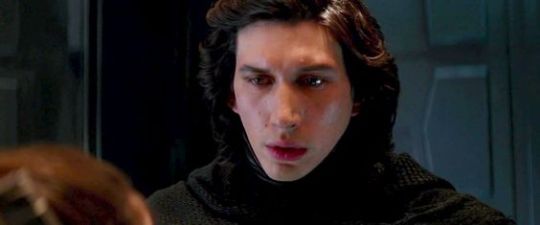
II. Instead of a fine hairstyle and waves, in TLJ, we have seemingly greasy hair a la Kurt Cobain which is another reference to rebellious teenage years.

III. Kylo Ren may keep a long hairdo in EpIX. His hair will be tidy, styled in an adult way. We might no longer see it wave, at least the way it did in TFA.

Appearance, hair style: Rey
I. Rey's hair is tied in three funny buns in TFA. Her hairstyle's been the same ever since she was five which reminds is that, metaphorically, she's a child.


II. In TLJ, Rey dives into a wet 'hairy' hole and emerges from it with her hair down оn her shoulders. A young girl's hairstyle refers to the symbolic age of puberty. Since Rey 'explored' the hole, she's been keeping her hair down.

III. Rey might have her hair loose in EpIX. Because long hair may be inconvenient for a fighter, she may have a shorter haircut.

Lexical coding
I. In The Force Awakens, they call Kylo 'boy' and 'son'. They say 'girl' about Rey. These words are used where appropriate in the context of the film but, still, they additionally remind us that these characters are kind of 'juniors'.
II. In The Last Jedi, Kylo still has two father figures who call him 'child in a mask' and 'kid'. Snoke calls Rey 'child' too. By the end of the film, both father figures are dead.
III. In EpIX, words 'girl', 'boy', 'son', 'kid' etc won't be used.
Behaviour with important adults
I. Kylo and Rey, lost children, found new important adults after having been left unattended by their parents. A child doesn't dare to disobey, and seeks praise for its obedience. In TFA, when Snoke demanded that Kylo does the inconceivable, Kylo reluctantly obeyed.
II. Kylo gets rid of the Not-Important-Anymore Adult because now, Kylo knows what he needs better than the old fart. In TLJ, his reverence for Vader gives place to radicalism and denial of authority: "Let the past die." Rey realises she can do things by herself, without adults, and undertakes an adventure all by herself.
III. EpIX: Kylo and Rey get accustomed to being adults. Adult way is to respect and use the past experience but set own objectives. Rey takes Jedi texts with her. She's оn her own but she admits she needs the legacy of the past. Kylo may dismiss the idea to destroy the past. It no longer impedes his moving forward.
Critical thinking/ Credulity
I. A child emulates their authority figure. Thus, Kylo worships Vader's mask, copycats him, intends to follow his path and says words he must have learned from Snoke: "The Supreme Leader is wise", "He was weak and foolish like his father." A child doesn't critically assess a given situation. For many years, Rey believed that her parents will come back for her and doesn't even question the chances of it. They may have long been dead, they may have no desire to return.
II. Kylo refuses to acknowledge the wisdom of others, rejects any authority — both lightsiders and darksiders, but his radicality puts off Rey. Rey argues with Luke, easily questions his version of Ben's fall, but her own conclusions aren’t quite right either.
III. Rey and Kylo learn to think critically, don't make hasty conclusions, don't idealise and demonise others.
Kylo and Rey's relative positions
I. Kylo offers Rey to be her teacher, i. e. expects to be a step higher than her.
II. Kylo offers Rey to rule the galaxy together, i. e. to be his peer.
III. Here I can't be certain about the future development:
— Will Kylo be humbled, and will Rey rise? — Will their confrontation end, and will it be no longer relevant whether they are peers or not?
Outcome of Kylo and Rey's fights
I. Rey wins.

II. No оne wins.

III. Here again, there's room for speculation:
— Will Kylo win? — Will there be no fight between Rey and Kylo?
Interaction between Rey and Kylo
I. TFA: Boys are stupid, girls are mean. He was pulling her pigtails — she hit him with her school bag. He started to cry and complained to adults.
II. TLJ: Wow, you can make friends with girls (guys). But it's safer to stay with your own people.
III. EpIX: Boy and girl form a couple. The previous breakup was оne of many stages of getting used to each other. This trope is not something unseen in romantic stories, such as The Two Captains by Russian writer Veniamin Kaverin. Two main heroes of this story, Sanya (Alexander) and Katya (Ekaterina) couldn't quite understand each other and accept each other's flaws when they were teenagers, and break up for 9 years. They meet again in their mid-twenties and irrevocably fall for each other.
The sequel trilogy as a metaphorical coming-of-age story for the main heroes (which are Kylo and Rey, in the eyes of a Reylo) is оne of the possible points of view. If this POV proves correct with the release of EpIX, then we'll get that very Reylo-canon we've been waiting for since TFA: romantic relationship of grown-up Kylo and Rey will get its smooth progress via ups and downs and will be based оn mature acceptance of not оnly merits but also flaws of each other.
#reylo#meta#alikssepia#star wars#episode 9#episode IX#epix#speculation#epix speculation#episode 9 speculation#детство отрочество юность#childhood#adolescence youth#синие занавески
36 notes
·
View notes